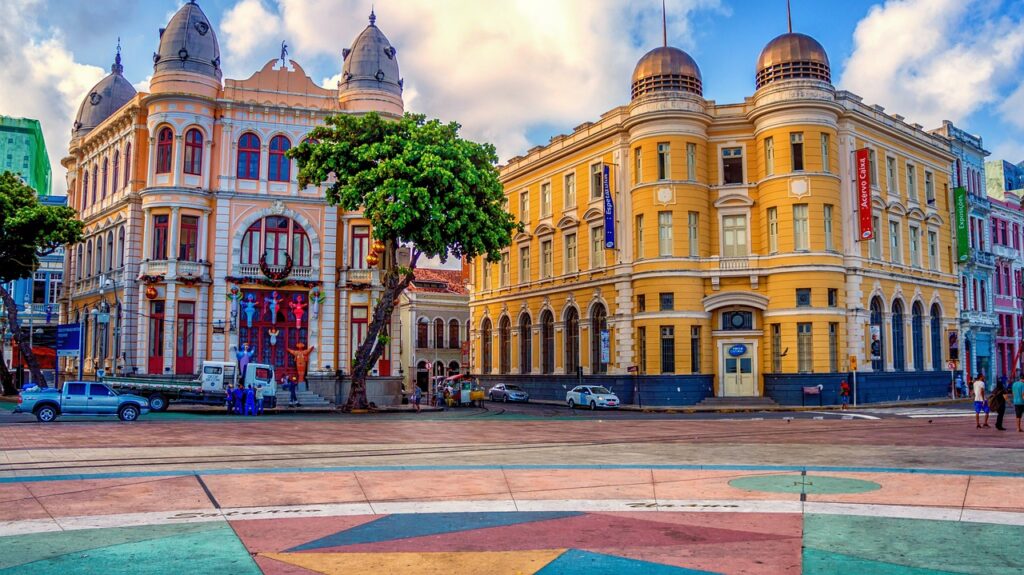I. Carnival in Brazil: A Feast of Culture and Tradition
Carnival in Brazil is not merely a celebration; it is an explosion of color, rhythm, and cultural vitality that sweeps across the country with unbridled enthusiasm. This introduction sets the stage for an exploration of one of the world’s most iconic and exuberant festivals.
Brazil’s Carnival is a global phenomenon, drawing travelers from all corners of the earth to partake in its festivities. It is a time of revelry and merriment, where the streets come alive with music, dance, and an infectious spirit of joy. The grandeur of Brazil’s Carnival is a testament to the nation’s passion for celebration.
Beyond the glittering costumes and pulsating samba beats, Carnival carries deep cultural and historical importance. Rooted in a blend of indigenous, African, and European traditions, it reflects Brazil’s diverse heritage. Carnival is a living tapestry of stories, a celebration of freedom, and an expression of cultural pride. This introduction provides a glimpse into the heart and soul of Brazil’s Carnival, setting the stage for a more in-depth exploration of this extraordinary event.
II. Origins and Traditions: Tracing the Roots of Brazilian Carnival
As we delve deeper into the heart of Brazil’s Carnival, it becomes essential to uncover its origins and traditions. This section will illuminate the historical and cultural underpinnings of the celebration, exploring the intricate tapestry of influences that have shaped this extraordinary event.
A. The Historical Roots of Carnival in Brazil
To understand the essence of Brazilian Carnival, it is crucial to trace its historical roots. From its inception as a European celebration to its transformation into a unique Brazilian spectacle, we will explore how this vibrant tradition took shape.
B. Traditional Carnival Practices and Customs
Every Carnival celebration is steeped in traditions, from elaborate parades to the donning of intricate costumes. This subsection will offer an insight into the customary practices that define Brazil’s Carnival, showcasing the rituals that have been passed down through generations.
C. The Influence of African, European, and Indigenous Cultures
One of the defining features of Brazil’s Carnival is its rich tapestry of cultural influences. African, European, and Indigenous cultures have all played a pivotal role in shaping the celebration. This section will shed light on how these diverse influences have converged to create the Carnival we know today. By exploring the historical roots, traditions, and cultural amalgamation of Carnival, readers will gain a deeper appreciation for the intricacies of this remarkable event.
III. Preparing for Carnival: Costumes, Dance, and Regional Diversity

As the excitement for Carnival builds, those eager to participate must prepare not only for the festivities but also for the unique experiences the celebration offers. This section equips readers with the knowledge and skills needed to fully immerse themselves in Brazil’s Carnival.
A. Costume Selection and Creation
Carnival is synonymous with lavish, ornate costumes that captivate the eye. We will delve into the art of choosing or crafting the perfect costume, whether it’s an intricate samba outfit, a historical ensemble, or a whimsical creation that reflects individual style.
B. Learning Popular Dance Styles Like Samba
To truly partake in the Carnival spirit, understanding and mastering dance, especially samba, is essential. This subsection provides insight into the rhythmic and sensual movements that bring the celebration to life, offering tips and guidance for dance enthusiasts.
C. Understanding the Diverse Carnival Celebrations in Different Regions
Brazil’s vast expanse means that Carnival can vary greatly from region to region. This part of the guide introduces readers to the diverse Carnival celebrations found throughout Brazil, from the grandeur of Rio de Janeiro to the local charm of smaller towns. By learning about costume choices, dance styles, and the regional nuances of Carnival, readers will be well-prepared to immerse themselves in this exceptional event.
IV. Rio de Janeiro Carnival: Where Grandeur Meets the Streets
Among the countless Carnival celebrations in Brazil, Rio de Janeiro’s stands out as an opulent extravaganza that sets the world on fire. This section guides readers through the unmatched glamour and energy of Rio’s Carnival.
A. The Grandeur of the Sambadrome Parade
Rio de Janeiro’s Sambadrome parade is the pinnacle of Carnival grandeur. We’ll explore this world-renowned spectacle, from its awe-inspiring floats and costumes to the fierce competition among samba schools for the title of champion.
B. Samba Schools and Their Competitive Performances
Rio’s Carnival revolves around samba schools, each with its own unique identity. This subsection offers an in-depth look at these institutions, their history, and the competitive performances that make Rio’s Carnival so electrifying.
C. Street Parties and Blocos in Rio
While the Sambadrome parade is the highlight of Rio’s Carnival, the city’s streets come alive with an array of vibrant blocos (street parties). We’ll provide insights into these spontaneous, neighborhood celebrations, where everyone can join the fun. By uncovering the grandeur of the Sambadrome, the captivating world of samba schools, and the lively street parties in Rio, readers will gain a comprehensive understanding of this iconic Carnival destination.
V. Salvador Carnival: A Carnival Experience Like No Other
Salvador, with its distinctive Carnival, offers a unique and immersive experience that sets it apart from other Brazilian celebrations. In this section, we’ll delve into the vibrant and unforgettable Salvador Carnival.
A. The Electric Trios and Massive Street Parties
Salvador’s Carnival is renowned for its electric trios, massive mobile sound systems that lead crowds in euphoric street parties. We’ll uncover the pulsating energy of these trios and the streets overflowing with revelers.
B. The Role of Axe Music and Dance
Axe music is the heartbeat of Salvador’s Carnival, providing the rhythm that drives the city’s celebrations. Readers will gain an understanding of this unique music genre, its significance in Salvador, and the mesmerizing dance that accompanies it.
C. The Camarotes and Their VIP Experience
Salvador’s Carnival also offers a VIP experience through camarotes, private viewing boxes that provide an elevated view of the festivities. This subsection explores the exclusive world of camarotes, where comfort meets the excitement of Carnival. By exploring the electric trios, axe music, and the VIP experience of Salvador’s Carnival, readers will be well-prepared to revel in the distinct charm of this Carnival celebration.
VI. Other Major Carnival Cities: Beyond the Icons
While Rio and Salvador take the spotlight, Brazil’s other major cities also boast vibrant and distinctive Carnival celebrations. In this section, we’ll explore the diverse experiences offered by these lesser-known Carnival destinations.
A. São Paulo Carnival and Its Unique Attractions
São Paulo’s Carnival presents a distinct experience with its emphasis on samba school competitions and a lively samba parade. We’ll unravel the unique features of this Carnival, from its grandeur to the opportunities for community engagement.
B. Olinda and Recife Carnival in the Northeast
The Northeast of Brazil offers a different Carnival experience, particularly in Olinda and Recife. These cities are known for their rich cultural heritage, traditional frevo music and dance, and charming historic streets. We’ll delve into the cultural significance of their celebrations.
C. Florianópolis Carnival in the South
Florianópolis, located in the South of Brazil, combines Carnival traditions with stunning beach landscapes. This subsection will explore how Carnival-goers in Florianópolis can enjoy both the lively festivities and the natural beauty of the region. By examining the unique attractions of São Paulo, the cultural richness of Olinda and Recife, and the coastal charm of Florianópolis during Carnival, readers will gain a comprehensive perspective on the diverse Carnival experiences in Brazil.
VII. Carnival Outside Brazil: A Global Celebration of Brazilian Culture
Brazilian Carnival has transcended borders, inspiring celebrations in communities around the world and influencing global Carnival traditions. In this section, we’ll explore how Brazilian culture and Carnival have found a place on the international stage.
A. Brazilian Communities and Their Celebrations Abroad
Brazilians living abroad have brought their Carnival traditions with them, creating a slice of Brazil in foreign lands. We’ll uncover how these expatriate communities celebrate Carnival and keep their cultural connections alive.
B. Influence on Global Carnival Traditions
The vibrancy of Brazilian Carnival has influenced Carnival celebrations worldwide. From the Caribbean to Europe, we’ll take a closer look at how Brazilian Carnival has left its mark on international festivities. By examining Brazilian communities abroad and the global influence of Brazilian Carnival, readers will gain insight into the widespread impact of this exuberant Brazilian tradition.
VIII. Carnival’s Impact on Brazilian Culture: Beyond the Festivities
Carnival in Brazil is not just a celebration; it’s a cultural phenomenon with far-reaching effects on society, the economy, and cultural identity. In this section, we’ll delve into the profound impact of Carnival on Brazilian culture.
A. Social, Economic, and Cultural Significance
We’ll explore how Carnival is deeply ingrained in the social fabric of Brazil, its influence on the economy, and its role in preserving cultural traditions. Readers will gain an understanding of how Carnival goes beyond a party and serves as a reflection of Brazilian identity.
B. Promoting Tourism and Cultural Exchange
Brazilian Carnival is a significant driver of tourism, attracting visitors from across the globe. We’ll examine how Carnival serves as a platform for cultural exchange, bringing people together to celebrate Brazil’s rich heritage.
C. Challenges and Controversies
Despite its jubilant nature, Carnival also faces challenges and controversies, such as issues related to safety, inclusivity, and environmental impact. We’ll shed light on these aspects, providing a balanced perspective on the complex realities of Brazil’s Carnival. By delving into the multifaceted impact of Carnival on Brazilian culture, readers will gain a deeper appreciation for the significance and complexities of this cultural phenomenon.
IX. Carnival Music and Dance: Rhythmic Heartbeats of Celebration
At the core of Carnival’s exuberance are its vibrant music and captivating dance. In this section, we’ll immerse ourselves in the rhythms, melodies, and movements that set the Carnival spirit in motion.
A. Samba, Axé, Frevo, and Other Musical Genres
We’ll explore the diverse musical genres that provide the soundtrack for Carnival. From the timeless beats of samba to the infectious energy of axé and the lively sounds of frevo, we’ll uncover the cultural significance and regional variations of these genres.
B. Dance Styles and Their Cultural Expressions
Dance is an integral part of Carnival, each region with its unique styles and cultural expressions. We’ll delve into the graceful samba, the spirited frevo, and the contagious axé dance, among others, to understand how movement tells a story during Carnival.
C. Musical Instruments and Their Role in Carnival
The music of Carnival is brought to life by a range of traditional instruments. We’ll take a closer look at the drums, percussion, brass, and string instruments that form the backbone of Carnival music, showcasing their importance in creating the festive atmosphere.
By exploring the rich variety of musical genres, dance styles, and the instruments that fuel the Carnival’s dynamic spirit, readers will gain an in-depth understanding of how music and dance are the heartbeat of this grand celebration.
X. The Samba Schools: Nurturing Carnival’s Artistry
Samba schools are the driving force behind the grandeur of Carnival, meticulously preparing for their performances. In this section, we’ll uncover the vital role samba schools play in Carnival and the intricate processes behind their dazzling presentations.
A. The Importance of Samba Schools in Carnival
We’ll emphasize the central role that samba schools hold in the entire Carnival spectacle, acting as the creative powerhouses that craft and execute the spectacular parades.
B. The Elaborate Preparations and Performances
Readers will gain insight into the year-long preparations, costume design, choreography, and rehearsals that lead up to Carnival. We’ll also explore the awe-inspiring performances during the Sambadrome parades.
C. The Community and Cultural Significance of Samba Schools
Samba schools are not just about Carnival; they are also hubs for community engagement and cultural preservation. We’ll delve into how samba schools serve as pillars of local culture and identity.
By delving into the inner workings and cultural significance of samba schools, readers will develop a profound appreciation for the dedication and artistry that underpin the grandeur of Carnival.



